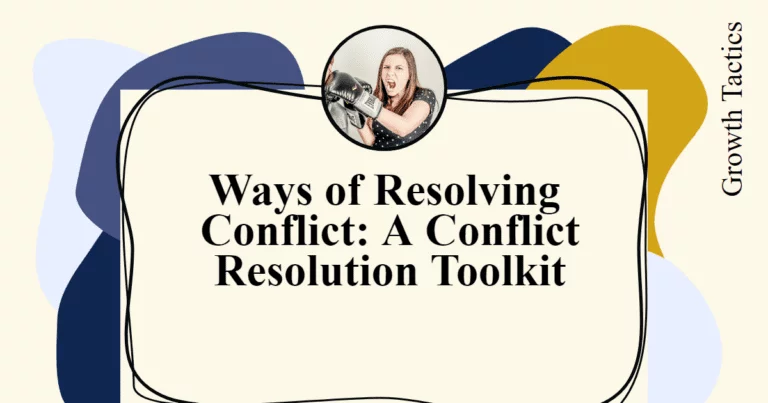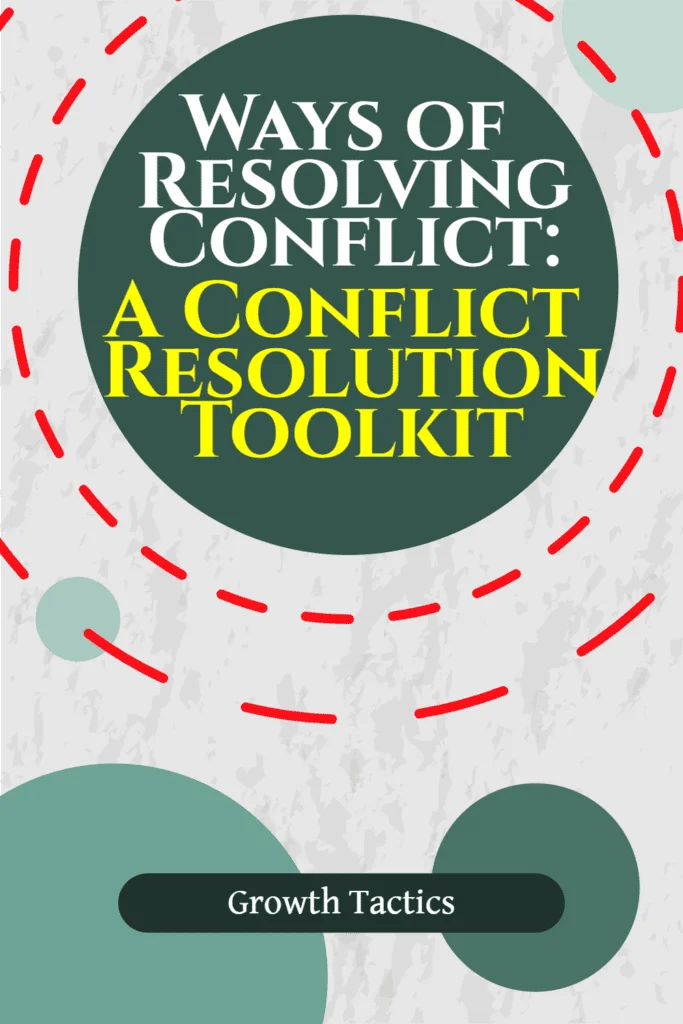Conflict is inevitable in any workplace. When conflict at work arises, knowing how to handle and resolve it in a healthy, constructive way is critical for maintaining positive relationships and productivity. Conflict resolution is the process of resolving a dispute or disagreement between two or more people through conciliation to the mutual satisfaction of both parties.
Developing strong conflict resolution skills is crucial for creating a culture of trust, respect, and collaboration in the workplace. Unresolved conflict often results in tension, lost productivity and can even lead to aggressive behavior or violence in extreme situations. That’s why learning positive techniques for resolving conflict can benefit both employees and organizations.
By mastering these conflict resolution techniques, you can become more adept at handling disagreements in a constructive way. Let’s get started!
Jump To Section
Common Causes of Workplace Conflict
Conflict in the workplace is inevitable, but it can be productive if handled constructively. Common causes of workplace conflict include:
Poor communication: When employees do not communicate clearly or frequently enough, misunderstandings can occur. Lack of communication is one of the most common causes of conflict between coworkers or teams. Make sure expectations are explicit and conversations are open.
Unclear expectations: When employees are unsure of their roles and responsibilities or expected results and behaviors, confusion and conflict can result. Setting clear objectives and key results (OKRs) and defining success metrics helps align everyone to the same goals.
Different values/personalities: Employees have different work styles and belief systems that may clash. Striving to understand where others are coming from and finding common ground helps bring divergent perspectives together. Focus on shared goals and organizational values.
Competition over resources: When teams or individuals compete for territory, headcount, budget or time allotment, conflict can ensue. Ensure resources are distributed equitably and transparently based on need. Foster a collaborative and team mentality.
Negative Impacts of Unresolved Conflict
Conflict management is vital, as unresolved conflict can have detrimental effects on productivity, morale, and performance. Here are some of the top negative impacts of letting conflicts fester in the workplace:
Reduced productivity: When employees are embroiled in conflict, they spend time and energy dealing with interpersonal tension instead of focusing on their work. This leads to missed deadlines, lackluster work quality, and overall lower productivity.
Dysfunctional work environment: Unresolved conflicts create tension in the office, eroding trust between team members. People may avoid collaborating or communicating, harming coordination. Anger, resentment, and stress from conflict create a toxic culture.
High turnover: Good employees don’t want to work in a dysfunctional environment filled with conflict. When problems aren’t addressed, frustration builds and employees start looking for jobs elsewhere. Unresolved conflict leads to higher churn.
Reputation damage: Word of a stressful, chaotic work environment filled with arguments spreads quickly. This harms recruiting as top talent won’t want to join. Current customers may also be hesitant to work with an organization that can’t resolve internal disputes.
The negative ripple effects of unresolved conflicts emphasize why it’s critical for managers to address issues proactively and constructively. Letting problems fester leads to reduced performance across key metrics.
Healthy vs Unhealthy Conflict
Conflict can be healthy or unhealthy. Healthy conflict leads to personal and organizational growth, while unhealthy conflict can be destructive. Here are some key differences:
Healthy Conflict
- Focuses on issues, not personalities
- Seeks understanding of different perspectives
- Leads to solutions that meet everyone’s core needs
- Improves relationships and builds trust
- Enhances creativity, innovation and critical thinking
- Addresses problems before they become unmanageable
Healthy conflict is constructive and leads to positive outcomes. It arises from differences that can be discussed respectfully. The goal is to find solutions that satisfy both parties.
Unhealthy Conflict
- Becomes personalized and emotional
- Focuses on blaming or attacking others
- Seeks to undermine the other party
- Damages trust and relationships
- Stalls progress and wastes time
- Leads to disengagement and avoidance
Unhealthy conflict is destructive and prevents growth. It stems from unmet needs and fears. The parties view each other as opponents and avoid engaging cooperatively. This causes problems to fester and relationships to deteriorate.
Recognizing the differences between healthy and unhealthy conflict is key. With self-awareness and communication skills, workplace conflict can be transformed into an opportunity for positive change.
Tips for Managing Your Emotions
When emotions run high, it can be difficult to have a productive discussion. Here are some tips to help you manage your emotions during conflict:
Take a timeout to cool down. If you feel yourself getting upset, take a break to calm down before continuing the conversation. A few deep breaths can go a long way. Resume the discussion when you have a cooler head.
Avoid accusatory language. Blaming or attacking will only escalate the conflict. Use “I feel…” statements to express your perspective without putting the other person on the defensive.
Don’t take feedback personally. Constructive feedback on your work or ideas is not a personal attack. Try to listen objectively and find value in the feedback.
Focus on shared goals. Remind yourself that you likely both want what’s best for the team or organization. Concentrate on your shared interests rather than proving the other person wrong.
Keeping your emotions in check will lead to more productive conflict resolution. With self-awareness and empathy, you can navigate challenging conversations.
Active Listening Techniques for Conflict Resolution
Active listening is a critical technique for resolving conflict. When emotions are running high, it’s easy to misinterpret what someone is saying. Active listening helps ensure you fully understand the other person’s perspective.
Here are some tips for active listening during a conflict:
Make eye contact and nod occasionally to demonstrate you are engaged and paying attention. Maintain an open posture.
Paraphrase what the other person said to confirm your understanding. For example, “So what I’m hearing is that you feel overwhelmed with the extra projects I’ve assigned. Is that correct?”
Ask clarifying questions if anything is unclear. Don’t make assumptions. Asking questions shows you want to understand their viewpoint.
Avoid interrupting. Allow the other person to fully explain their perspective without interjecting your own opinions.
Summarize the key points you heard and ask if you understood correctly.
Active listening requires focus and patience. It establishes trust and shows respect for the other person during conflict resolution. When both parties feel heard, it becomes easier to find solutions.
Finding Common Ground to Resolve Conflict
When parties involved in a conflict focus on their differences, it’s easy for tensions to escalate. However, taking time to identify shared interests and goals can help you find common ground. Here are some tips:
Have an honest discussion about what each party wants out of the situation. Look for overlapping interests and desired outcomes. For example, both sides may want a respectful workplace environment.
Propose solutions that satisfy everyone’s core needs. Don’t get bogged down in rigid positions – be open to flexibility and compromise. Present options where each party gets some of what they want.
Focus the conversation on mutual gains instead of concessions. Frame proposals in a positive way – how can both sides benefit? Avoid zero-sum thinking where one side must lose for the other to win.
Identify shared values and principles that transcend the conflict. Appealing to common ground like integrity, fairness, and teamwork can unite people.
Keep dialogue focused on the future and moving forward, rather than rehashing the past. Work together to achieve goals.
Be willing to agree to disagree on some issues. Not every detail requires complete agreement. Seek consensus on the core components that matter most.
The key is having a collaborative mindset where the parties involved make joint decisions that meet their mutual interests. This prevents destructive win-lose mentalities and enables everyone to feel heard and satisfied. Conflict can then transform into an opportunity for growth.
When to Involve Mediation
There are certain situations when it’s wise to bring in an objective third party to help resolve a conflict. Mediation can be very effective in the following circumstances:
For complex or emotional conflicts – Sometimes conflicts involve complex issues, high tensions, or strong emotions that make it difficult for the parties to communicate constructively on their own. An experienced mediator can help facilitate more productive conversations.
When communication has broken down – If the conflict has escalated to the point where the people involved are no longer talking to each other, mediation may help reopen lines of communication so a resolution can be reached. The mediator serves as an impartial intermediary to keep communication flowing.
To prevent escalation – Mediation is useful early on before conflicts worsen. Managing and resolving conflict is vital, as an unaddressed conflict can grow and cause increasing dysfunction and hostility. Mediation helps address issues before irreparable damage is done to work relationships.
Involving a professionally trained mediator provides structure to the resolution process. The mediator helps define the issues, sets ground rules, guides communication, finds common interests, and helps generate mutually acceptable solutions. Mediation can often achieve conflict resolution faster and with less lingering resentment compared to letting conflicts continue unmediated.
Implementing Agreements
Once an agreement has been reached, it’s important to take steps to ensure it is carried out successfully. Here are some tips:
Create an action plan with deadlines/milestones. Break down the agreement into smaller action steps and set deadlines for when each will be completed. This creates accountability and keeps things moving forward.
Build in review sessions. Schedule regular check-ins to review progress on the action steps. This allows you to catch any issues early and make adjustments to the plan if needed.
Celebrate successes. When milestones are reached, take time to recognize it and appreciate each other’s efforts. This positive reinforcement will help motivate ongoing cooperation. Even small wins are worth celebrating.
Follow up in writing. Send an email or memo recapping the agreement and action plan so there is documentation. This way expectations are clear.
Keep leadership informed. Let your manager or HR know the agreement reached and progress made. Transparency helps ensure continued alignment and support.
Implementing agreements takes dedication and follow-through from all involved. But it pays off by strengthening relationships and resolving conflicts for good. Celebrating successes along the way makes it a positive experience.
Creating a Culture of Healthy Conflict
As a leader, you can foster a culture that normalizes healthy conflict by:
Modeling open communication. Be vulnerable and share times you’ve struggled to have difficult conversations. Seek feedback often and listen without defensiveness. Admit when you’re wrong. Praise those who constructively challenge you.
Rewarding compromise and growth. Highlight examples of team members finding creative solutions. Publicly recognize those who step up as mediators. Share the growth you see in individuals as they increase empathy and conflict skills.
Providing conflict resolution training. Invest time and resources into building your team’s emotional intelligence and communication abilities. Enlist experts to teach tactics for conflict management, stress management, and nonviolent communication in the workplace.
Being proactive. Don’t wait for conflicts to arise before setting expectations of mutual respect, active listening, taking responsibility, and finding third alternatives. Institute regular touch points and anonymous surveys to surface issues early. Move quickly in addressing tensions.
Adopting these principles helps conflict become an everyday part of your culture. With practice, your team becomes more trusting, cohesive, and able to constructively work through challenges. Healthy conflict leads to increased innovation, stronger relationships, and better outcomes.


